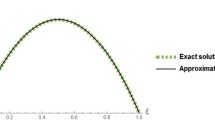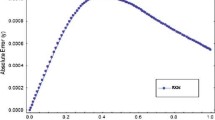Abstract
This paper presents iterative reproducing kernel algorithm for obtaining the numerical solutions of Bagley–Torvik and Painlevé equations of fractional order. The representation of the exact and the numerical solutions is given in the \( \hat{W}_{2}^{3} \left[ {0,1} \right] \), \( W_{2}^{3} \left[ {0,1} \right] \), and \( W_{2}^{1} \left[ {0,1} \right] \) inner product spaces. The computation of the required grid points is relying on the \( \hat{R}_{t}^{{\left\{ 3 \right\}}} \left( s \right) \), \( R_{t}^{{\left\{ 3 \right\}}} \left( s \right) \), and \( R_{t}^{{\left\{ 1 \right\}}} \left( s \right) \) reproducing kernel functions. An efficient construction is given to obtain the numerical solutions for the equations together with an existence proof of the exact solutions based upon the reproducing kernel theory. Numerical solutions of such fractional equations are acquired by interrupting the \( n \)-term of the exact solutions. In this approach, numerical examples were analyzed to illustrate the design procedure and confirm the performance of the proposed algorithm in the form of tabulate data, numerical comparisons, and graphical results. Finally, the utilized results show the significant improvement in the algorithm while saving the convergence accuracy and time.



Similar content being viewed by others
References
Mainardi F (2010) Fractional calculus and waves in linear viscoelasticity. Imperial College Press, London
Zaslavsky GM (2005) Hamiltonian chaos and fractional dynamics. Oxford University Press, Oxford
Podlubny I (1999) Fractional differential equations. Academic Press, San Diego
Samko SG, Kilbas AA, Marichev OI (1993) Fractional integrals and derivatives theory and applications. Gordon and Breach, New York
Kilbas A, Srivastava H, Trujillo J (2006) Theory and applications of fractional differential equations. Elsevier, Amsterdam
Bagley RL, Torvik PJ (1984) On the appearance of the fractional derivative in the behavior of real materials. J Appl Mech 51:294–298
Bagley RL, Torvik PJ (1983) Fractional calculus—a different approach to the analysis of viscoelastically damped structures. AIAA J 21:741–748
Ghorbani A, Alavi A (2008) Application of He’s variational iteration method to solve semidifferential equations of nth order. Math Probl Eng. doi:10.1155/2008/627983
Podlubny I, Skovranek T, Jara BMV (2009) Matrix approach to discretization of fractional derivatives and to solution of fractional differential equations and their systems. In: Proceedings of the IEEE conference on emerging technologies and factory automation (ETFA’09), pp 1–6
Raja MAZ, Khan JA, Qureshi IM (2011) Solution of fractional order system of Bagley–Torvik equation using evolutionary computational intelligence. Math Probl Eng. doi:10.1155/2011/675075
Fadravi HH, Nik HS, Buzhabadi R (2011) Homotopy analysis method based on optimal value of the convergence control parameter for solving semi-differential equations. J Math Ext 5:105–121
Zolfaghari M, Ghaderi R, Eslami AS, Ranjbar A, Hosseinnia SH, Momani S (2009) Sadati J (2009) Application of the enhanced homotopy perturbation method to solve the fractional-order Bagley–Torvik differential equation. Phys Scr T136:014032
Wang ZH, Wang X (2010) General solution of the Bagley–Torvik equation with fractional-order derivative. Commun Nonlinear Sci Numer Simul 15:1279–1285
Ray SS (2012) On Haar wavelet operational matrix of general order and its application for the numerical solution of fractional Bagley Torvik equation. Appl Math Comput 218:5239–5248
Yüzbaşi S (2013) Numerical solution of the Bagley–Torvik equation by the Bessel collocation method. Math Methods Appl Sci 36:300–312
Cenesiz Y, Keskin Y, Kurnaz A (2010) The solution of the Bagley–Torvik equation with the generalized Taylor collocation method. J Frankl Inst 347:452–466
Hesameddini E, Peyrovi A (2009) The use of variational iteration method and homotopy perturbation method for Painlevé equation I. Appl Math Sci 3:1861–1871
Raja MAZ, Khan JA, Ahmad SUL, Qureshi IM (2012) A new stochastic technique for Painlevé equation-I using neural network optimized with swarm intelligence. Comput Intell Neurosci. doi:10.1155/2012/721867
Raja MAZ, Khan JA, Shah SM, Samar R, Behloul D (2015) Comparison of three unsupervised neural network models for first Painlevé transcendent. Neural Comput Appl 26:1055–1071
Dehghan M, Shakeri F (2009) The numerical solution of the second Painlevé equation. Numer Methods Partial Differ Equ 25:1238–1259
Saadatmandi A (2012) Numerical study of second Painlevé equation. Commun Numer Anal. doi:10.5899/2012/cna-00157
Raja MAZ, Khan JA, Siddiqui AM, Behloul D, Haroon T, Samar R (2015) Exactly satisfying initial conditions neural network models for numerical treatment of first Painlevé equation. Appl Soft Comput 26:244–256
Fornberg B, Weideman JAC (2011) A numerical methodology for the Painlevé equations. J Comput Phys 230:5957–5973
Fornberg B, Weideman JAC (2015) A computational overview of the solution space of the imaginary Painlevé II equation. Phys D 309:108–118
Hesameddini E, Latifizadeh H (2012) Homotopy analysis method to obtain numerical solutions of the Painlevé equations. Math Methods Appl Sci 35:1423–1433
Cui M, Lin Y (2009) Nonlinear numerical analysis in the reproducing kernel space. Nova Science, New York
Berlinet A, Agnan CT (2004) Reproducing kernel Hilbert space in probability and statistics. Kluwer Academic Publishers, Boston
Daniel A (2003) Reproducing kernel spaces and applications. Springer, Basel
Weinert HL (1982) Reproducing kernel Hilbert spaces: applications in statistical signal processing. Hutchinson Ross, Stroudsburg
Lin Y, Cui M, Yang L (2006) Representation of the exact solution for a kind of nonlinear partial differential equations. Appl Math Lett 19:808–813
Wu B, Li X (2010) Iterative reproducing kernel method for nonlinear oscillator with discontinuity. Appl Math Lett 23:1301–1304
Abu Arqub O, Al-Smadi M, Shawagfeh N (2013) Solving Fredholm integro-differential equations using reproducing kernel Hilbert space method. Appl Math Comput 219:8938–8948
Abu Arqub O, Al-Smadi M (2014) Numerical algorithm for solving two-point, second-order periodic boundary value problems for mixed integro-differential equations. Appl Math Comput 243:911–922
Momani S, Abu Arqub O, Hayat T, Al-Sulami H (2014) A computational method for solving periodic boundary value problems for integro-differential equations of Fredholm–Voltera type. Appl Math Comput 240:229–239
Abu Arqub O, Al-Smadi M, Momani S, Hayat T (2015) Numerical solutions of fuzzy differential equations using reproducing kernel Hilbert space method. Soft Comput. doi:10.1007/s00500-015-1707-4
Abu Arqub O (2015) Adaptation of reproducing kernel algorithm for solving fuzzy Fredholm–Volterra integrodifferential equations. Neural Comput Appl. doi:10.1007/s00521-015-2110-x
Abu Arqub O (2016) The reproducing kernel algorithm for handling differential algebraic systems of ordinary differential equations. Math Methods Appl Sci. doi:10.1002/mma.3884
Abu Arqub O (2016) Approximate solutions of DASs with nonclassical boundary conditions using novel reproducing kernel algorithm. Fundam Inform 145:1–24
Geng FZ, Qian SP (2015) Modified reproducing kernel method for singularly perturbed boundary value problems with a delay. Appl Math Modell 39:5592–5597
Jiang W, Chen Z (2013) Solving a system of linear Volterra integral equations using the new reproducing kernel method. Appl Math Comput 219:10225–10230
Wang WY, Han B, Yamamoto M (2013) Inverse heat problem of determining time-dependent source parameter in reproducing kernel space. Nonlinear Anal Real World Appl 14:875–887
Geng FZ, Qian SP (2013) Reproducing kernel method for singularly perturbed turning point problems having twin boundary layers. Appl Math Lett 26:998–1004
Jiang W, Chen Z (2014) A collocation method based on reproducing kernel for a modified anomalous subdiffusion equation. Numer Methods Partial Differ Equ 30:289–300
Geng FZ, Qian SP, Li S (2014) A numerical method for singularly perturbed turning point problems with an interior layer. J Comput Appl Math 255:97–105
Acknowledgments
The authors would like to express their gratitude to the unknown referees for carefully reading the paper and their helpful comments.
Author information
Authors and Affiliations
Corresponding author
Ethics declarations
Conflict of interest
The authors declare that they have no conflict of interest.
Rights and permissions
About this article
Cite this article
Abu Arqub, O., Maayah, B. Solutions of Bagley–Torvik and Painlevé equations of fractional order using iterative reproducing kernel algorithm with error estimates. Neural Comput & Applic 29, 1465–1479 (2018). https://doi.org/10.1007/s00521-016-2484-4
Received:
Accepted:
Published:
Issue Date:
DOI: https://doi.org/10.1007/s00521-016-2484-4
Keywords
- Reproducing kernel algorithm
- Fourier series expansion
- Fractional-order derivative
- Bagley–Torvik equation
- Painlevé equation




